Physical Address
304 North Cardinal St.
Dorchester Center, MA 02124
Because most patients with tumors of the head and neck initially present to the surgeon, it is the surgeon's responsibility to do a comprehensive examination of the head and neck area, accurately assess the tumor and assign the stage of the disease, discuss treatment options, obtain appropriate multidisciplinary input, and initiate treatment planning. Accordingly, the head and neck surgeon must have a basic understanding of the biology of the disease and the factors involved in cancer management, including tumor and host factors as well as the principles and effectiveness of available treatment modalities. If surgery is selected as the initial definitive treatment, the surgeon should focus on thorough preparation of the patient for surgery. This process includes patient education, a preoperative medical evaluation as well as a dental evaluation if required, speech and swallowing assessment, and psychological consultation as required. This is essential to obtain an informed consent from the patient.
Before proceeding with surgery, it is essential to have a detailed discussion with the patient and provide counseling regarding the nature and severity of the disease, its impact on the selection of therapy, the treatment options available, the pros and cons of each approach, and the details of the operative procedure if surgery is recommended as the preferred choice of treatment. The sequelae and morbidity of surgery and possible complications should be discussed with the patient and appropriately documented as part of the informed consent process. Central to this discussion is the understanding and realistic expectations by the patient and family members. In addition, the patient should be informed about what to anticipate in the postoperative period. This discussion should stress the need for breathing exercises and early ambulation to prevent complications. Patients undergoing laryngectomy require specific preoperative counseling, including consultation with a speech pathologist, review of voice rehabilitation, and video education regarding expected sequelae. Similarly, patients who are expected to have significant functional or aesthetic sequelae after surgery also require specific counseling and access to support services.
A key factor contributing to perioperative morbidity is current tobacco use. Smoking causes changes in cardiopulmonary function that can have unfavorable implications for patients undergoing prolonged anesthesia. Smokers are at an increased risk for postoperative pulmonary complications as well as free flap failure. Smoking-induced changes in cardiopulmonary function can be minimized by preoperative abstinence from smoking. Accordingly, appropriate counseling for cessation and support services are an essential part of preoperative preparation. The period before surgery is also an excellent time to initiate efforts at permanent smoking cessation. Similarly, perioperative β-blockade has been shown to reduce the incidence of myocardial ischemia, myocardial infarction, and long-term overall mortality related to cardiac events after surgery in patients at high cardiac risk. It is believed that the beneficial effects of β-blockers result from a positive balance of myocardial oxygen supply and demand. The current recommendations for perioperative β-blockade for patients at high risk for a perioperative cardiac event are to begin use of a β-blocker several weeks before a planned operation, titrate the dose to achieve a heart rate of 60 to 70 beats per minute, and taper the dose in the postoperative period.
The basic preoperative assessment includes a detailed history and physical examination, a complete blood cell count, routine biochemistry tests, urinalysis, an electrocardiogram, and a chest radiograph. In addition, overall poor general medical status and the presence of comorbid conditions warrant the need for a preoperative medical or cardiology consultation. Although advanced age by itself is not a contraindication for surgery, comorbidities that are more common in older patients may require specific preoperative evaluation and optimization. In advanced tertiary care centers, special Geriatric Services are available. If such resource is available, then a preoperative geriatrics consultation should be obtained. In general, most medications can be continued until the day of surgery with the exception of anticoagulants, such as aspirin, warfarin (Coumadin), and any other antiplatelet agents, which should be stopped 5 days before surgery if medically acceptable. For patients in whom anticoagulants cannot be stopped, warfarin should be switched to short-acting anticoagulants that can be withheld on the day of surgery. Because antihypertensive agents that target angiotensin-converting enzyme can cause severe hypotension during anesthesia, they also should be discontinued before surgery.
In addition to medical optimization, postoperative management issues also should be addressed before surgery. If significant or prolonged pain is expected, a pain management specialist should be consulted preoperatively. Psychological consultation and counseling also may be considered preoperatively if a patient (or family member) is having significant problems with stress or coping. In addition, a history of heavy alcohol use warrants prophylaxis for delirium tremens, which should be instituted in collaboration with a psychiatrist. Effective treatment of delirium tremens relies on early identification of patients at risk before symptoms develop, use of benzodiazepines (e.g., lorazepam) for withdrawal prophylaxis, and then gradual tapering for detoxification.
Traditionally, the preparation of patients for surgery has included shaving of hair from the intended surgical site the night before the operation. It is now recognized that shaving in advance of surgery can lead to hair follicle irritation and infection, and accordingly it is no longer recommended. When necessary, hair removal should be performed in the operating room with use of electric clippers. The use of sharp razors (even safety razors) is discouraged.
The design of the operating room should accommodate all the required equipment and yet provide easy access to the patient. To facilitate the free flow of personnel and equipment, a minimum of 800 square feet of floor space is desirable. The operating room setup for head and neck surgery requires at least two overhead operating lights and an operating table with the flexibility to position the patient as required. Procedures that require two surgical teams working simultaneously are ideally performed in an operating room with two sets of overhead operating room lights. In contemporary operating rooms, digital imaging, operative endoscopy and microscopy, electrocautery, various energy devices for coagulation, and other basic surgical instruments should be available. A typical setup of a contemporary head and neck operating room is shown in Fig. 2.1 .
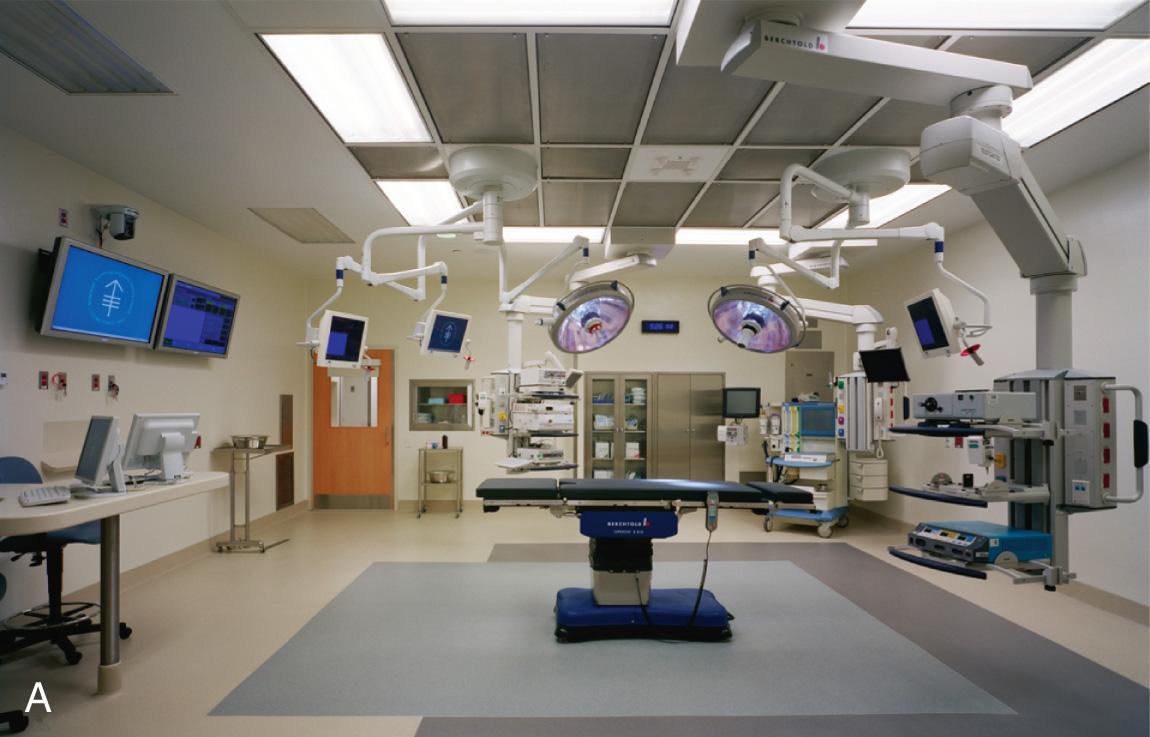
Standardized operating room setup allows operations to be conducted smoothly. Most head and neck surgical procedures can be performed with a single surgical team consisting of the operating surgeon, the first and second assistant surgeons, and a scrub nurse. Complex operations of the skull base, mediastinum, or thorax and free flap procedures require more than one surgical team. Some select situations require two teams to work simultaneously. When multiple surgical teams are involved, the surgical plan and sequence should be discussed with the entire team, which includes the anesthesiologist and operating room personnel. Similarly, for robotic surgery, the setup requires specific positioning of the patient, the operating table, and the robotic console.
As a general rule the operating surgeon stands on the side of the operative field, with the first assistant at the head end of the table and the second assistant directly across on the opposite side of the surgeon. The endotracheal tube and the anesthesia circuit are directed diagonally away from the operative field at the head end, to be connected to the anesthesia machine. In general, the scrub nurse should stand on the same side as the surgeon, with the Gerhardt instrument table brought over the operating table and up to the level of the umbilicus of the patient ( Fig. 2.2 ). The electrocautery cords and suction tubing are directed into the operative field between the scrub nurse and the surgeon and are secured to the drapes. Wastebaskets are positioned for easy access by the surgeon and in sight of the scrub nurse so that the contents are readily visible.
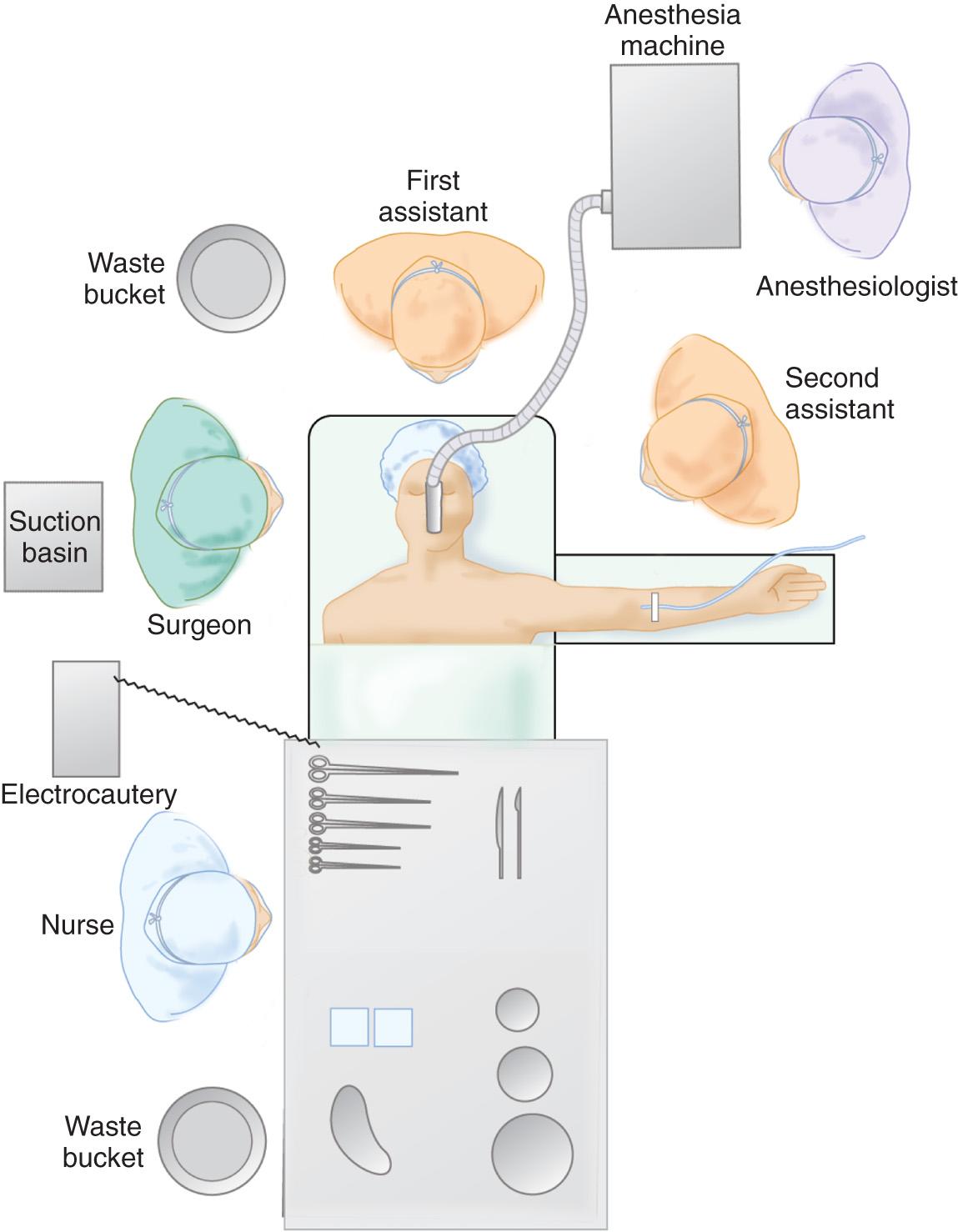
A sterile field generally is not required for endoscopic surgical procedures. The procedure is performed with the use of either endoscopes or an operating microscope. If a carbon dioxide laser is used, the appropriate laser precautions should be in place. Transnasal and transoral endoscopic surgery requires a full complement of endoscopes as well as specialized insulated instruments and suction coagulators. The setup and positioning of the operative equipment and personnel are shown in Fig. 2.3 .
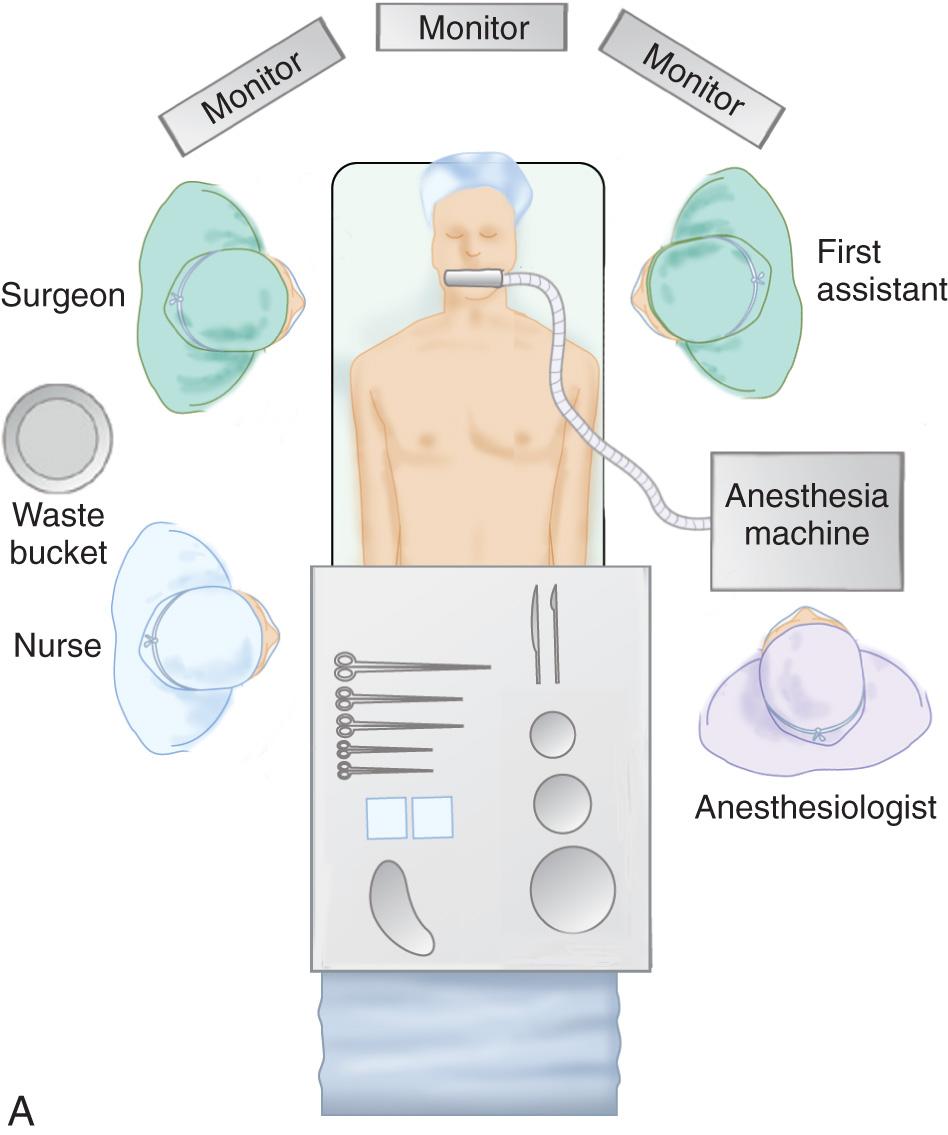
Setup for robotic surgery requires generally a larger operating room to accommodate the robotic console and the robot itself ( Fig. 2.4 ). The robotic console may be located in a convenient location in the room away from the operating table and anesthesia equipment. In addition, to position the robot for transoral surgery, adequate space is necessary at the head end of the table, with space for the assistant to sit and work in the oral cavity to assist the surgeon operating the robotic arms. The assistant may need to use the suction machine or may be required to provide additional retraction or to apply vascular clips for hemostasis. Thus, by necessity, the anesthesia tubing and circuit are extended to have the anesthetic equipment at a distance from the endotracheal tube .
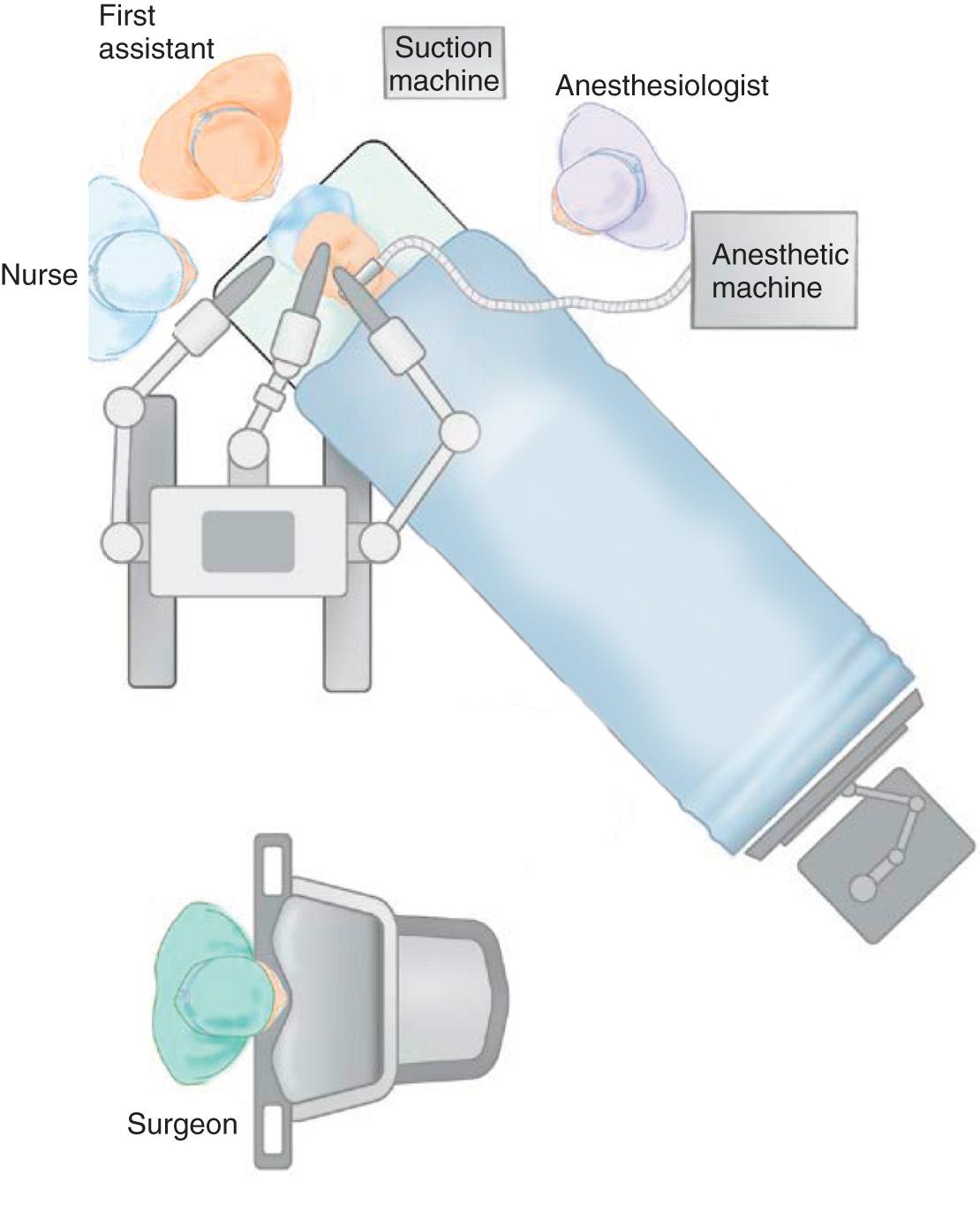
Craniofacial surgery for tumors involving the skull base requires planning of the operating sequence to prevent confusion and crowding at the operating table. The patient is prepared and draped for simultaneous access by both the neurosurgical and the head and neck teams, even though many stages of the operation are performed sequentially by one team at a time. When both teams are working simultaneously, the head and neck surgeon works from the same side as the lesion, with the first assistant between the head and neck surgeon and the neurosurgeon, who works from the head end of the table. The operative setup is depicted in Fig. 2.5 . Two sets of powered instrumentation including the appropriate drills, saws, and electrocautery and suction equipment are necessary for this complex operative procedure.
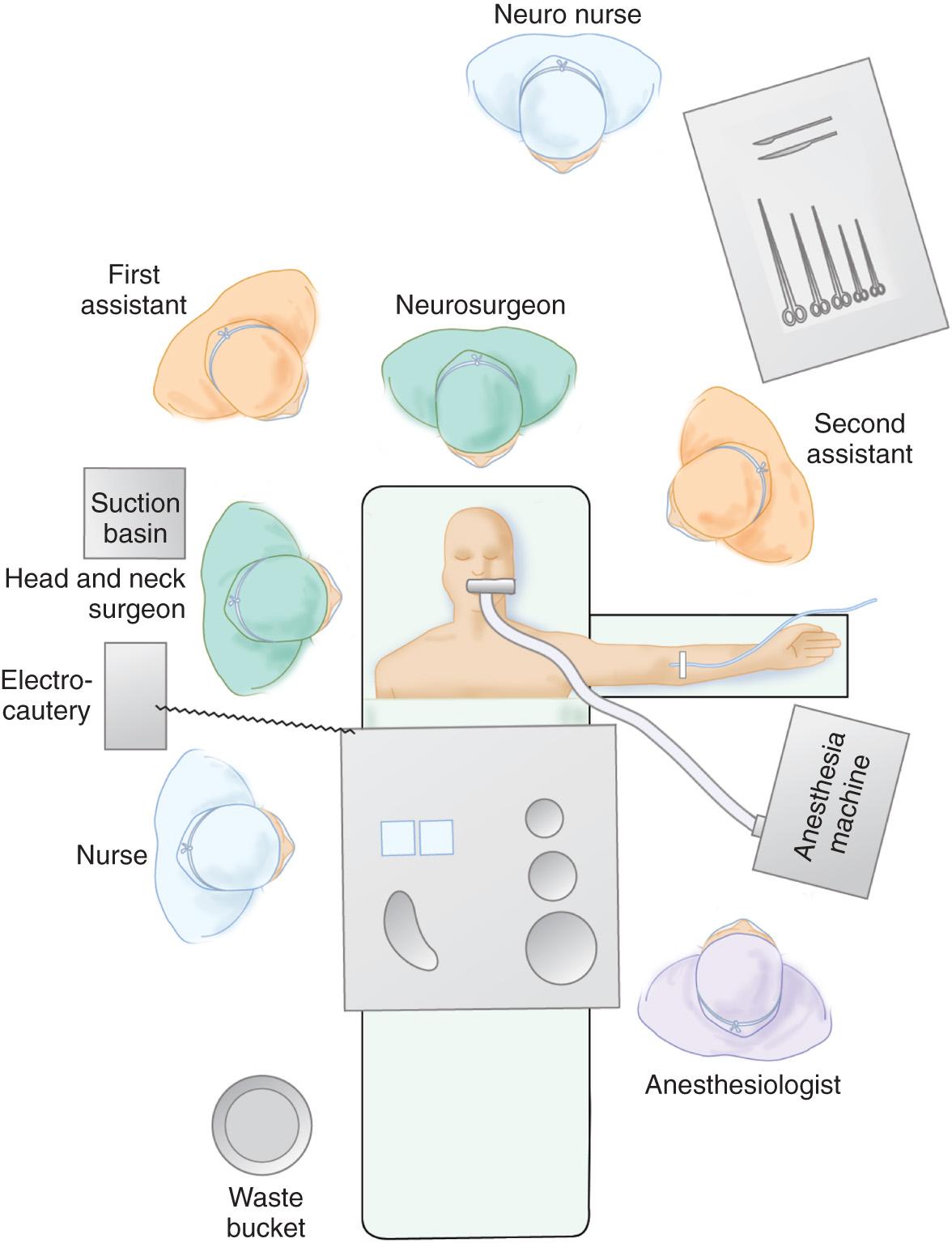
Become a Clinical Tree membership for Full access and enjoy Unlimited articles
If you are a member. Log in here